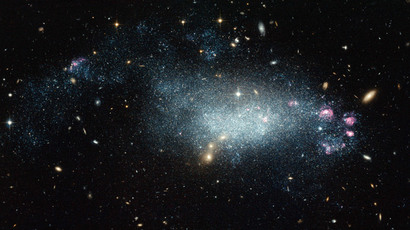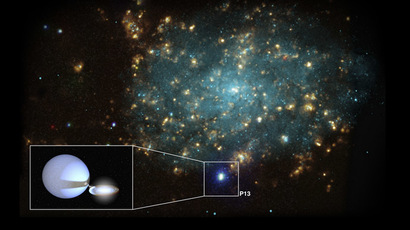Supermassive black holes could be part of an interstellar cosmic web

Astronomers have discovered that the black holes at the center of some galaxies are strangely aligned with other black holes across billions of light years in distance. The remarkable discovery implies the makings of an interstellar cosmic web.
If true, the revelation could reveal many secrets of the universe.
READ MORE:1,000 times stronger than Chelyabinsk meteorite: New asteroid may threaten Earth
Scientists think the new discovery could provide answers about how cosmic rays are produced, and solve a key mystery about how the universe operates. The answers came from fresh data gathered at the Very Large Telescope (VLT) in Chile by a team of scientists from the University of Liege, Belgium, showing the unusual alignment between the enormous interstellar objects called “quasars” – also known as a galaxy with a supermassive black hole at its center.
“The first odd thing we noticed was that some of the quasars’ rotation axes were aligned with each other — despite the fact that these quasars are separated by billions of light-years,” said Damien Hutsemékers.
Black Holes aligned? Wow! http://t.co/PJaPK08gbu
— Brick ONeil (@BrickONeil) November 22, 2014
The study centered on 93 bright quasars dating back to a time when the universe was only a third of its current age. Of these, 19 revealed enough information about their alignments to be measured.
“If true, this is like finding spinning tops spread out across space 15 times longer than our entire solar system are all tilted in the same direction,” Dr. Alan Duffy, an astrophysicist at Swinbourne University, told The Daily Telegraph. “Quasars are some of the brightest things in the universe, yet they’re actually caused by the darkest objects known — supermassive black holes.”

READ MORE:Finally detected? Elusive dark matter may be streaming from glaring Sun
Black holes can’t be seen but they can be detected by their “exhaust.” The gravity of black holes causes material to swirl around, heating up as it gets closer and spins faster until it’s glowing white hot. A closer look at the spacing of these quasars also revealed they were not evenly distributed.
“They form a cosmic web of filaments and clumps around huge voids where galaxies are scarce,” a statement from the research team reads. The quasars appear to be positioned in parallel to the “filament” in which they belong, the researchers said.
The biggest black holes ever found. Read about this monsters of the universe: http://t.co/lNfO8odE1t#space#cosmospic.twitter.com/fkuP0gFzDc,
— Niume (@niume_official) November 19, 2014
The team’s research, entitled “Alignment of quasar polarisations with large-scale structures,” was published today in the journal Astronomy & Astrophysics.
READ MORE:Super-hungry black hole gobbles star at rate previously thought impossible
“A correlation between the orientation of quasars and the structure they belong to is an important prediction of numerical models of evolution of our Universe,” research team member Dominique Sluse told The Daily Telegraph. “The alignments in the new data, on scales even bigger than current predictions from simulations, may be a hint that there is a missing ingredient in our current models of the cosmos.”














